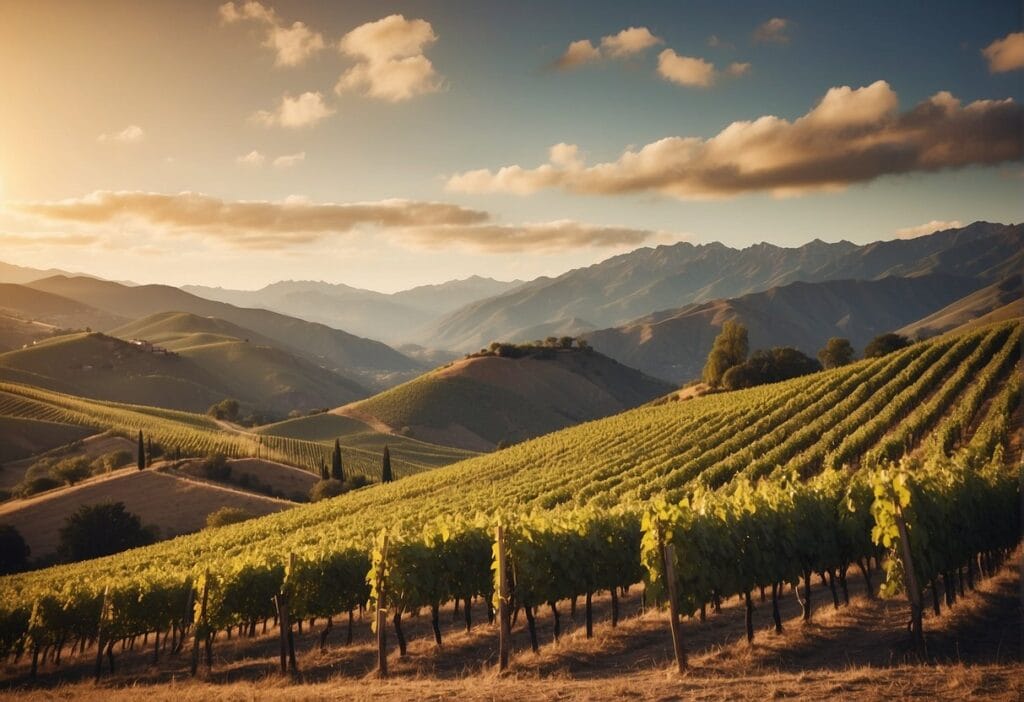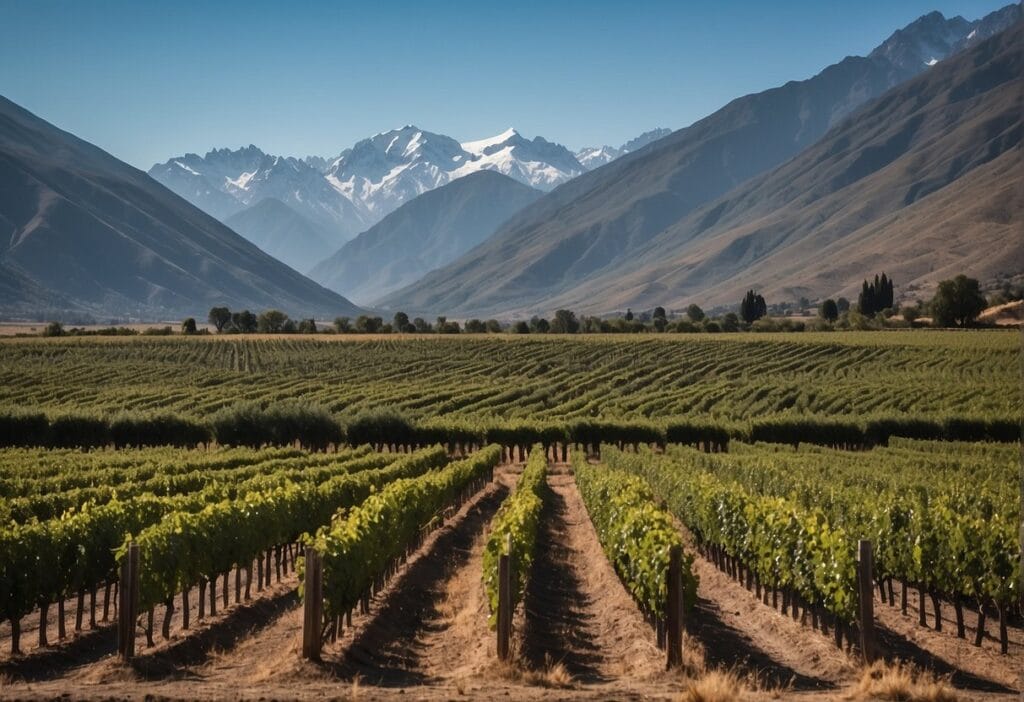South African winemaking has a fascinating history that spans from the colonial era to its modern-day resurgence. You’ll discover how this journey began over 350 years ago when Dutch settlers, led by Jan van Riebeeck, established a refreshment station at the Cape of Good Hope. They planted the first vineyards to produce wine for sailors passing through.

The Cape of Good Hope provided an ideal climate for grape growing, and soon South Africa was producing wines that garnered international recognition. However, the industry faced many challenges, including periods of economic hardship and competition from mass-produced wines. Despite these setbacks, winemakers like those at Klein Constantia and Hamilton Russell are now elevating the reputation of South African wine.
Today, South African winemaking is known for its innovation and quality. The industry combines traditional techniques with modern advancements, resulting in a diverse range of superb wines. Your journey through the history and evolution of South African winemaking will offer a deep appreciation for the resilience and passion of these winemakers.
Historical Origins and Early Influences
South African winemaking has deep roots tied to significant historical events and influential figures. Discover how the Dutch settlers, French Huguenots, and key individuals like Simon Van Der Stel shaped the iconic wine regions of South Africa.
The Dutch East India Company and Jan Van Riebeeck’s Initial Plantings
In 1652, the Dutch East India Company established a refreshment station at Cape of Good Hope. Jan Van Riebeeck, a representative of the company, was tasked with managing this station.
Van Riebeeck planted the first vineyards in 1655. His goal was to produce wine for sailors traveling to and from the East Indies. By 1659, the first wine was successfully produced, marking the beginning of South Africa’s winemaking journey. You can learn more about these early days at the History of South African wine.
French Huguenots and the Expansion of the Wine Industry
The arrival of the French Huguenots in 1688 significantly impacted the wine industry in the Cape Colony. Fleeing religious persecution in Europe, these settlers brought with them extensive knowledge of viticulture and winemaking practices from France.
They were given land in regions like Franschhoek. This increased the diversity of grape varieties and improved techniques, leading to higher quality wines. This influx of expertise was crucial in transforming the region’s fledgling wine industry into a more sophisticated and productive sector.
Simon Van Der Stel and the Establishment of Groot Constantia
Simon Van Der Stel, the Cape Colony’s Governor, played a pivotal role in the advancement of South African winemaking. In 1685, Van Der Stel founded Groot Constantia, one of the oldest wine estates in South Africa.
Located near Cape Town, Groot Constantia was established to create wines that could rival those of Europe. Van Der Stel’s efforts included experimenting with different grape varieties and innovative winemaking techniques. Today, Groot Constantia remains a key part of the South African wine heritage. Explore the history of this iconic estate at the Wines of the Rainbow Nation.
The Development of Varietals and Viticulture
South African winemaking evolved through the cultivation of native grape varieties, the integration of European varietals, and resilient responses to challenges like the Phylloxera epidemic.
Indigenous Grape Varieties and Their Characteristics
South Africa is home to unique grape varieties like Pinotage and Chenin Blanc (locally known as Steen). Pinotage, created in 1925 by Abraham Izak Perold, results from crossing Pinot Noir and Cinsault. It boasts flavors ranging from red berries to smoky undertones, showcasing versatility.
Chenin Blanc, or Steen, adapts well to South African terroirs, thriving in warm climates. It produces wines with notes of apple, pear, and honey. These grapes reflect the region’s diverse climate and soil.
Influence of Foreign Varietals on South African Terroirs
Dutch settlers introduced winemaking to South Africa in the 17th century. They planted vines from Europe, especially France. Over time, varietals like Cabernet Sauvignon, Merlot, and Chardonnay became popular.
French influence improved viticulture techniques and grape quality. You’ll find lush vineyards with Cabernet Sauvignon, bringing rich, bold wines, and Chardonnay, offering a range of flavors from citrus to butter. The blend of German, Italian, and Spanish varietals further enriched South African winemaking.
Phylloxera Epidemic and Its Aftermath
In the late 19th century, the Phylloxera epidemic devastated South African vineyards. The tiny insect attacked grapevine roots, causing widespread destruction. However, winegrowers were resilient. They adopted resistant American rootstocks, saving the industry.
You’ll notice that current viticulture practices focus on grafting European varietals onto these robust roots. This method overcomes past challenges, ensures vine health, and maintains the quality of wines like Shiraz and Sauvignon Blanc. Thanks to these efforts, South African wines remain strong and vibrant today.
The Political Landscape and Its Impact on Winemaking

The history of South African winemaking is deeply tied to the country’s political changes. Apartheid significantly hindered the wine industry, while the post-apartheid era opened doors to global markets and innovation.
Apartheid Era Struggles and the Wine Industry
During apartheid, South Africa’s wine industry faced severe challenges. The government implemented policies that segregated and oppressed the majority of the population. This had adverse effects on all sectors, including winemaking.
The KWV (Koöperatieve Wijnbouwers Vereniging), a large cooperative, dominated the industry. International sanctions further isolated South African wines from U.S. and world markets. Many Old World wine enthusiasts found the idea of supporting South African wine untenable due to the political situation.
The industry’s growth was stifled, with the focus primarily on producing bulk wine rather than quality. Black winemakers had limited opportunities, and the talent pool remained largely untapped. This period left a significant mark on the industry, setting it back years in terms of innovation and global presence.
Post-Apartheid Renaissance and Global Recognition
The end of apartheid marked a turning point. South Africa’s wine industry began a renaissance, embracing empowerment and sustainability. The government introduced policies to support black winemakers and diversify the industry.
With international sanctions lifted, South African wines began to gain recognition in the global wine industry. The focus shifted to producing high-quality and unique wines, positioning South Africa as a significant player among New World wine producers.
Modern South Africa has seen a surge in innovation and inclusion. Wine producers are now celebrated for their excellence, contributing to a vibrant and dynamic wine scene. The industry continues to grow, with South African wines achieving acclaim and winning awards worldwide.
Modern Innovations and Sustainable Practices

Modern South African winemaking integrates new techniques from around the world and emphasizes sustainable practices. This focus ensures quality production while promoting environmental and social responsibility.
Adoption of New World Winemaking Techniques
South African vintners have embraced New World winemaking techniques. Inspired by regions like America and Australia, innovative approaches include new fermentation methods and creative blending techniques. For instance, the use of the Pinotage grape, uniquely South African, is now combined with classic French winemaking techniques to create the renowned Cape Blend.
Regions like Stellenbosch, Franschhoek, and Swartland are at the forefront, leveraging modern technology and practices. This adoption has led to wines that showcase the country’s terroir while appealing to a global market, enhancing both the wine industry and wine tourism.
Certification and Promotion of Sustainable Viticultural Practices
Sustainability in viticulture is essential to preserving the environment and enhancing the wine industry’s future. Many South African wineries pursue certifications such as Integrated Production of Wine (IPW) and biodynamic farming certifications. These certifications ensure that sustainable practices are consistently applied across vineyards.
Franschhoek and Paarl lead in promoting these practices, focusing on the long-term health of their vineyards through organic methods and the use of natural biostimulants like seaweed. Erna Blancquaert’s work exemplifies this effort, aiming to make wines more sustainable and reduce environmental impacts.
Adopting these practices not only enhances the quality of the wines but also contributes to the global reputation of South African wines. This commitment to sustainability supports economic resilience and social responsibility, attracting conscious consumers and supporting local communities.
The Culture and Experience of Wine in South Africa

South African winemaking is more than just producing wine; it’s about experiencing the rich culture and history surrounding it. There are numerous estates and regions that offer unique experiences and exceptional wines.
Wine Tourism and the Role of Estates in South Africa
Wine tourism in South Africa is a thriving sector. When you visit, you’ll discover vineyards spread across stunning landscapes like the Stellenbosch and Franschhoek Valley. These estates, including iconic ones like Constantia Estate and Klein Constantia, offer tours and tastings that delve into the country’s winemaking processes.
Wine farms are the heart of this experience. They provide guided tours through the vineyards, cellars, and offer tastings of their best wines. This gives you a hands-on look at what makes South African wine special.
Additionally, several estates host events, from wine and food pairings to seasonal festivals. These events celebrate the vibrant culture and community spirit that is deeply entwined with winemaking in the region.
Prominent Wine Regions and Their Unique Offerings
South Africa’s wine regions each offer something unique. The Stellenbosch region is known for its university vibe, thanks to its proximity to Cambridge University Press. It’s famous for exceptional Cabernets and Chardonnays, and the estates such as Rustenberg.
In the Franschhoek Valley, you can explore vineyards with French influences, featuring Huguenot-descended estates. It’s renowned for its exquisite white wines and aesthetically pleasing, luxury wine estates.
The Paarl region boasts diverse varietals and offers historical estates that date back centuries. Last but not least, Constantia, one of the oldest wine-producing areas in the world, is famed for its sweet wines and historic estates like Constantia Estate.
Each region allows you to sample various styles and learn about the unique processes and history that define South African wine.

